What is black carrot: where does it grow and does it really exist
Not so long ago, a new culture began to appear in the gardens of Russia - black carrots or scorzonera. Not all gardeners are still familiar with it.
Let's figure out what it is, what such a carrot is used for and how to grow this scorzonera.
The content of the article
Description of black carrot scorzonera
In the photo you can see what a black carrot looks like. Let's consider in more detail its main characteristics.

Origin and development
The scientific name for black carrots is Spanish goat (Scorzonera hispanica). It is also often referred to as "black root" or "sweet root". Biologically, it belongs to the Asteraceae family - that is, this culture is absolutely not close to our usual sowing carrots: their relationship is approximately like that of an ordinary mouse and a bat, that is, only at the class level.
Scorzonera is biologically closer to chicory than carrots... The name stuck with us due to the fact that the cultivation technology is close to carrot, and the root itself outwardly resembles some varieties of carrots.
This perennial plant comes from Southern Europe and Southwest Asia. Now it is grown in all European countries, in Russia it is found in the south of the European part, in the Caucasus and in Western Siberia.
The plant has been cultivated as a vegetable crop since about the 16th century, although in folk medicine it was used even earlier: according to one of the hypotheses, the word "scorzonera" comes from the Spanish "escorzon" - snake venom, because it was believed that the juice of this root is an antidote for a snake bite.
Chemical composition and useful properties
Scorzonera root is rich in vitamins (primarily C and group B), calcium and iron. It lacks the beneficial carotene responsible for the orange color of regular carrots, but it does contain many other unique substances:
- Inulin - a polysaccharide that helps to normalize blood cholesterol levels.
- Asparagine - an amino acid that participates in the synthesis of proteins by the body, and most importantly, it binds the ammonia formed in the metabolism.
- Levulininvolved in the regulation of blood sugar levels.
Due to its rich chemical composition, black carrots are recommended for people with anemia and vitamin deficiency. In addition, it supports immunity well, and therefore can be used to prevent influenza and SARS. Despite its sweet taste, it does not increase glucose levels, and therefore is recommended for inclusion in the diet for people suffering from diabetes.
Important! Scorzonera has no contraindications, but individual intolerance and allergies are possible. Therefore, if you try it for the first time, start with a small piece.
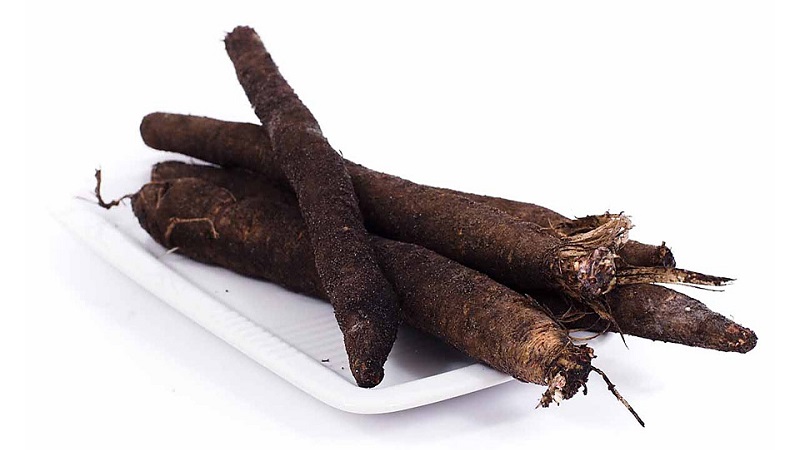
Application features
After peeling the black peel, the white flesh of the scorpion can be eaten raw or added to various salads.In addition, it is added to soups, lightly boiled or fried in vegetable oil - in this case, it turns out to be an excellent side dish for meat or fish.
It is believed that stewing scorzonera is undesirable - this kills its characteristic taste... But some cooks also add stewed black carrots to dishes. Scorzonera is also actively used in the preparation of soft drinks, jellies and marmalades - mainly juice is used, which gives the finished product a characteristic purple hue.
Scorzoneru used in traditional medicine as an anti-inflammatory and restorative agent.
Important! You can use young and not yet coarse leaves for food, but plucking them is still not recommended. Scorzonera has no deciduous varieties, and breaking off the tops leads to the fact that the root grows thinner and smaller. However, when breeding silkworms, black carrot leaves are used to feed them.
Ripening period
The ripening time of the scorpion depends on the purpose for which it is grown. In the case when it is eaten, one season is sufficient. Root ripening period:
- about 100-120 days for winter cultivation;
- 120-130 - for spring sowing.
If black carrots are grown for seeds, then it is planted before winter or, if the climate permits, left to winter in the ground: the seeds appear in the second year of cultivation.
Important! For sowing, seeds of the second year of cultivation must be used. If the scorchonera gave flower stalks in the first year, sowing them is not recommended: the root will grow hard and bitter, and the germination rate will be noticeably lower. Therefore, it is recommended to cut off the arrows in the first year.
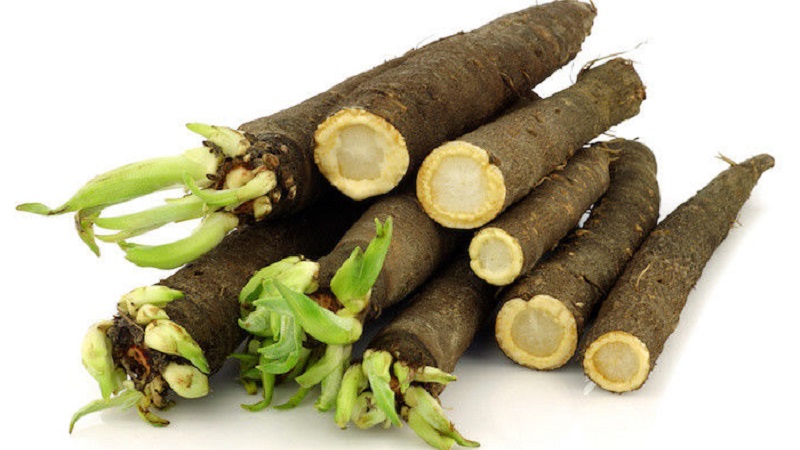
Yield
With proper cultivation, you can get yield about 1.5 - 1.8 kg of roots per 1 sq. m beds.
Disease resistance
There are no specific pests that threaten the scorzonera... It can be damaged by aphids and other leaf-eating insects. From diseases, the appearance of downy mildew is possible.
Characteristics, description of appearance, taste
Since black carrots are classified as asters, and not umbellate, like sowing carrots, the easiest way to distinguish scorzonera is precisely by the shape of the tops: it has a stem up to 75 cm high, branched and densely covered with leaves. The leaves themselves are green with a bluish tint, oblong, with a lot of veins.
Inflorescences in black carrots are few, single, and have the shape of baskets. They grow at the end of the arrows - flowering branches, usually growing in May-June. The flowers are light yellow, in an ovoid-pointed envelope.
Root - cylindrical, long... Its characteristic feature is a dark purple, almost black crust and light fleshy flesh, used for food.
The seeds of scorzonera are large, oblong, vaguely resembling a sunflower.
Root has an original taste that resembles a cross between asparagus and sweet radish... In 17th century France, this plant was even called "asparagus for the poor."
Interesting on the site:
For which regions it is best suited and what is the exacting climate
Despite the southern origin, black carrots are not very demanding on the climate., it is drought and frost resistant. In deep snow, it can withstand wintering with frosts down to -30 ° C. Therefore, it can be grown in any region where the duration of the warm period from warming up the soil to + 4 ... + 5 ° С and up to frost is more than 130 days.
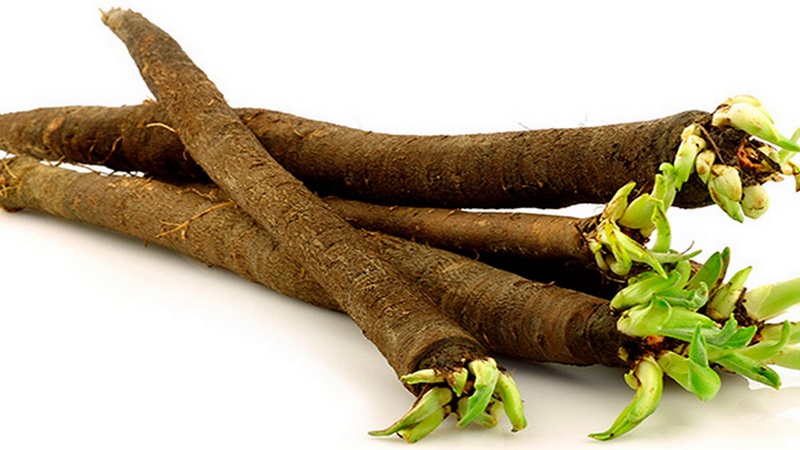
The main advantages and disadvantages of the species
Benefits of black carrots before other root crops:
- Original taste, rich in minerals.
- Scorzonera is indispensable for the nutrition of diabetics because of the herbal levulin contained in it.
- The ability to eat not only the roots, but also the leaves.
- Unpretentiousness.Scorzonera is not too demanding on the composition of the soil and frequent watering, although it needs some care.
- Pest resistance.
But there are also certain disadvantages.:
- Low yield. From the same area, ordinary carrots can be harvested 4-8 times more than black ones.
- Low keeping quality. Unlike sown carrots, black carrots are absolutely intolerant of damage. The root touched with a shovel must be immediately used for food, otherwise after 3-4 days it will deteriorate.
Difference from other varieties
Comparing black and regular carrots is difficult: these are plants of completely different families... Scorzonera is distinguished by both taste and appearance.
How and where it is used
The use of scorzonera is divided into two large groups:
- as a food plant;
- as a natural remedy for diabetes.
For the treatment of diabetes, the roots are used raw.: They can be gnawed or, for example, chopped or grated into small pieces and added with sunflower or olive oil to make a salad.
As for cooking, then black carrots are used:
- For filling soups. In this case, it is cleaned, cut into cubes and added shortly before cooking.
- As a side dish for meat or fish. Usually for this, the roots are lightly boiled and added to the main dish.
- As an ingredient in drinks. Scorzonera juice gives them an original flavor and shade.
- Raw - for salads.
Delicate young leaves can also be used in salads.
Features of planting and growing
The agrotechnics of scorzonera are generally close to those used for carrots, but they have their own nuances.
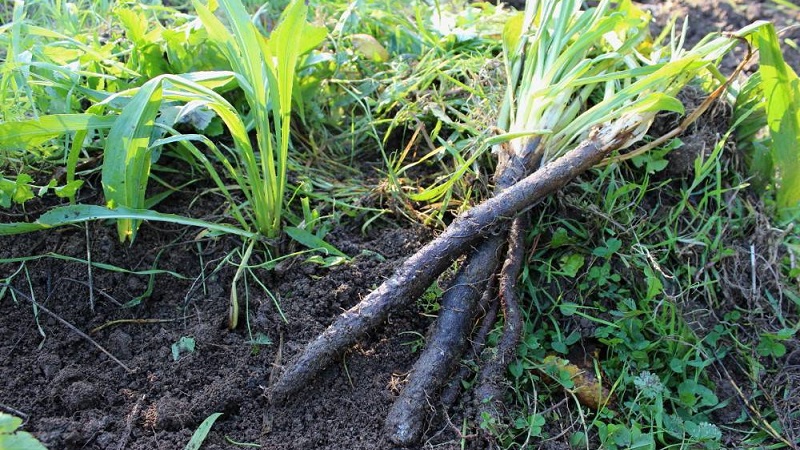
Preparing for landing
Feature of black carrots - low preservation of seeds... They quickly lose germination, and in the second year no more than a third of them germinate. Therefore, before sowing, it is better to soak the seeds and move only those that hatch into the ground.
You can sow scorzonera directly on the garden bed - it does not need seedlings. Before sowing, the garden bed should be prepared in advance: black carrots love loose soil, so you need to dig as deep as possible.
If possible, you should either dig for two bayonets - in this case, the top layer of soil is temporarily set aside and filled up on top of the dug bottom layer, or fill in high beds.
Organic matter is introduced into the soil in advance:
- with spring sowing - from autumn;
- when sown before winter - even under the predecessor plant.
Ground requirements
Black carrots grow well on any type of soil, but prefers loose loam, pre-fertilized with a large amount of humus. Scorzonera does not like fresh manure - when it is introduced, it "dubs" and begins to branch strongly, losing its taste and quality.
Also the acidity of the soil should be checked: Black carrots do not tolerate acidity well, so liming should be done if necessary.
The site must be chosen based on the following conditions:
- abundance of sun - scorzonera does not like shade;
- elevation - it is better to exclude ways of descent and stagnation of melt and rainwater;
- low groundwater level - at a high level in black carrots, roots may begin to rot.
Predecessors
Scorzonera cannot be planted after carrots, celery, spinach, cabbage and tomatoes - these plants have a similar type of root system, so the soil will be poor.
Quite good predecessors: potatoes, onions, garlic, all legumes. Scorzonera grows well in areas where green manure was grown before.
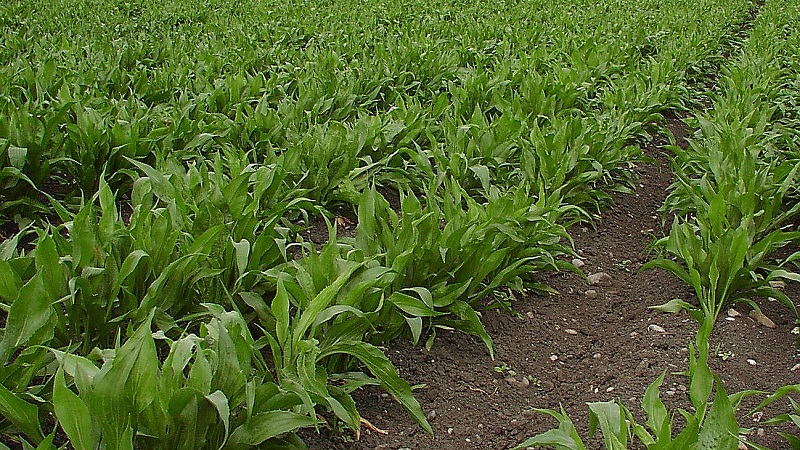
Timing, scheme and landing rules
There are two ways to sow black carrot seeds.:
- In the spring. Sowing is carried out in March - early April, then by autumn the roots will be thick and fleshy.
- In autumn before winter - at any time, until the soil temperature drops below + 5 ° С.
Seeds are sown in rows according to this pattern:
- row spacing - 30 cm;
- embedment depth - 2-3 cm;
- the distance between the seeds is 2-3 cm.
When planting before winter, the garden should be mulched with humus. or bottom peat - this will help the seeds to overwinter.
Seeds germinate within two weeks, with insufficient soil moisture - up to three weeks.
Read also:
Growing features
In general, the plant does not need special care... The only thing that a gardener needs to pay attention to is to carefully remove all peduncles in the first year: the seeds will still be of poor quality, and the root will become tough and tasteless because of them.
The nuances of care
Growing scorzonera is similar to growing carrots., but there are some minor differences.
Watering mode
Before sprouting, the garden bed is evenly moistened... The soil must not be overdried or overly watered. After each watering, the top layer of the bed should be carefully loosened so as not to damage the seeds and sprouts.
After the shoots have appeared, watering continues until about September, at least 4-5 times a month, depending on the weather. After watering or heavy rain, the beds are loosened so that the roots are even.
Thinning and weed control
Thinning is carried out at the stage of appearance of 2-3 leaves... There should be at least 7-8 cm between the plants. Leaves from thinned plants can be used for salad. It is impossible to transfer the removed seedlings: their roots will in any case be damaged and grow poor-quality.
The weeds are carefully weeded out, especially before sprouting: due to long germination, weeds have time to appear earlier. In the future, weeding is carried out as the weeds grow.
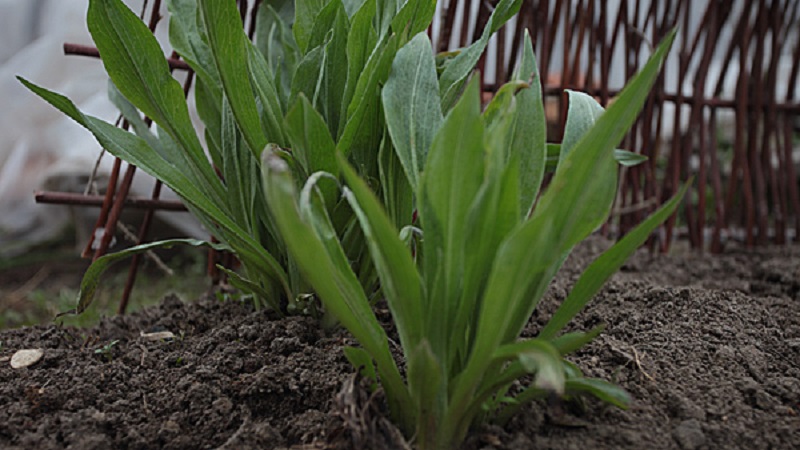
Top dressing
Top dressing is usually not required during cultivation... Before spring sowing in the fall, manure or compost is applied to the garden at the rate of a bucket per square meter. It will also be useful to add wood ash at the rate of at least a glass to the same area.
If the soil is poor, you can add to the soil before sowing nitroammofosk (80 g per 1 sq. m), or diammofosk (50 g for the same area). Also, during the season, you can apply the same substances twice a month until the end of August in the form of a solution at the rate of 25 g per 1 sq. m.
Disease and pest control
There are few specific diseases in black carrots:
- Powdery mildew - brown spots on the leaves, plants turn yellow and die. The method of struggle is spraying with a soap-vitriol solution (200 g of laundry soap and 20 g of copper sulfate per bucket of water). If it does not help, use synthetic drugs (for example, "Chistotsvet"). The use of biological products, such as "Fitosporin", also helps.
- Brown spot is a fungal disease in which light spots appear with a bloom (fungal spores). The method of struggle is the use of fungicides, from a solution of copper sulfate and Bordeaux liquid to specialized synthetic ones.
- Gray rot is also a fungal disease that manifests itself in the form of light brown, gradually growing spots on the leaves. It flows quickly and can destroy the plant in a matter of days. Control measures are the destruction of affected plants, the rest are sprayed with fungicides (Fundazol, Topsin-M and similar).
To avoid disease, it is important to avoid waterlogging of the soil., grow black carrots in sunny areas with neutral soil, observe crop rotation.
As for pests, then aphids, bears and slugs are dangerous for this culture... Measures to combat them:
- Slugs are helped by sprinkling the soil with slaked lime or superphosphate with a layer of 1-2 mm between the plants.
- Medvedka can be tried to drive away with the help of onion peel infusion. It will require 900 g of husk in a bucket of warm water, you need to insist 5 days. The finished infusion is diluted in a 1: 5 ratio and added to the soil three times a week.
- The easiest way to remove aphids is by hand using a damp sponge. If it does not help, you can use insecticides - "Aktara", "Bioverm" and similar.
In the garden and in the garden, in no case should the toads be driven away - they eat slugs... But colonies of black garden ants, on the contrary, must be carefully destroyed - they breed aphids.
Harvesting and storage
Harvesting black carrots is generally similar to harvesting conventional carrots, the only difference is the timing.
How and when to collect
Ripe is considered a scorzonera that has reached an age of 120-130 days... The exact date is not important here: it cannot overripe, therefore, cleaning is carried out after this date at a time when it is convenient for the gardener. If desired, scorzonera can be left in the soil almost until it snows. Moreover, they remove it in the spring - but then this must be done as soon as the snow melts, otherwise it will begin to grow again.
 When cleaning, such techniques are used:
When cleaning, such techniques are used:
- The root is carefully dug in and taken out together with a lump of soil. Better to use a pitchfork than a shovel.
- Black carrots are left in the garden for several hours, it is possible for 1-2 days, so that it dries slightly, and the excess soil crumbles from it. If there is a threat of rain, the crop is dried under a canopy.
- After that, the rosette of leaves is gently unscrewed from the plants for food, and they are laid for storage. Plants that are planned to be planted for seeds in the spring are stored along with the tops. However, it is better not to remove such specimens and leave them for the winter in the ground.
When removing scorzonera, remember that it is more fragilethan ordinary carrots, so you should not pull them out by the tops.
Storage features and keeping quality of the variety
The scorzonera is stored in the same way as other carrots. - in wet sand in a cool dark place. Do not let the roots dry out and wither - otherwise they will not survive and die.
Also it is unacceptable to store damaged roots: they will rot in a few days.
What can be the difficulties in growing
A gardener who has dealt with carrots will also cope with a scorpion.
Possible difficulties in growing can be:
- Low seed germination. Already in the second year they are almost unsuitable for sowing. Therefore, only fresh should be planted.
- Excessive soil moisture. Drainage should be done - or you should take into account the mistake and sow the seeds in another place next year.
Otherwise, this culture is unpretentious. and in summer it requires almost no special care.
Tips from experienced gardeners
Gardeners growing scorzonera share their recommendations:
- While it is easiest to sow seeds directly into the ground, black carrots can also be grown in seedlings. This significantly saves time and allows you to harvest earlier. But in this case, the transplant is done carefully and only by transshipment together with a lump of soil.
- The most delicious roots are found in plants sown in spring and not overwintering. Therefore, although black carrots can be left before winter, it is still better to remove them before freezing.
- Scorzonera can also be grown as an ornamental plant. Its flowers, although small, have a bright vanilla aroma.
Reviews of black carrot scorzonera
Consider how gardeners speak about the scorchonera.
Daria, Izhevsk: “I planted it exclusively from mice - I heard that it scares them away. Since then it has been growing by self-seeding. Sometimes I dig in one or the other root, but I don't remove it on purpose - nobody in the family liked the taste ".
Boris, Salavat: “We planted a bag for testing - so while we were driving home from the dacha, on the way we ate the whole harvested crop raw. Very unusual taste, something like oysters ".
Vitaly, Perm: “Sowed on loam. Everything grew together, but in the fall I could not remove it - all the roots broke, half remained in the ground. Since then I am afraid to get involved. And so - an interesting vegetable, the taste of a hazelnut resembles ".
Conclusion
The black carrot scorzonera is an interesting, albeit not yet widespread, culture. It is no more difficult to grow it than ordinary carrots, but it has much more useful properties. The only serious disadvantage of scorzonera is its low yield. We definitely recommend experimenting and planting this unusual carrot!